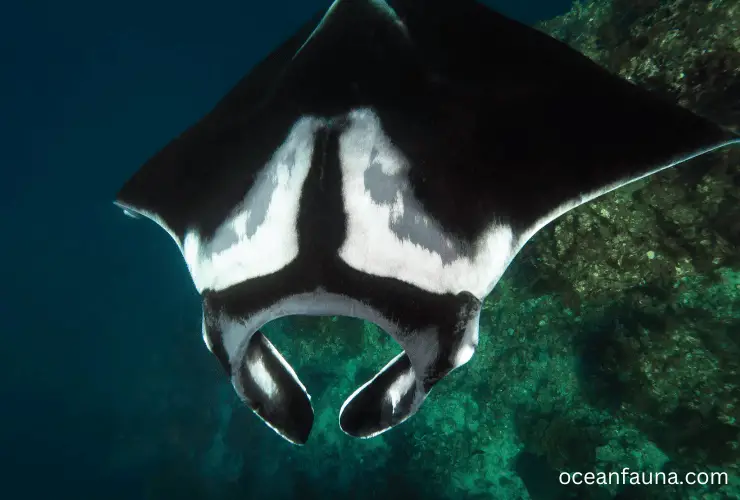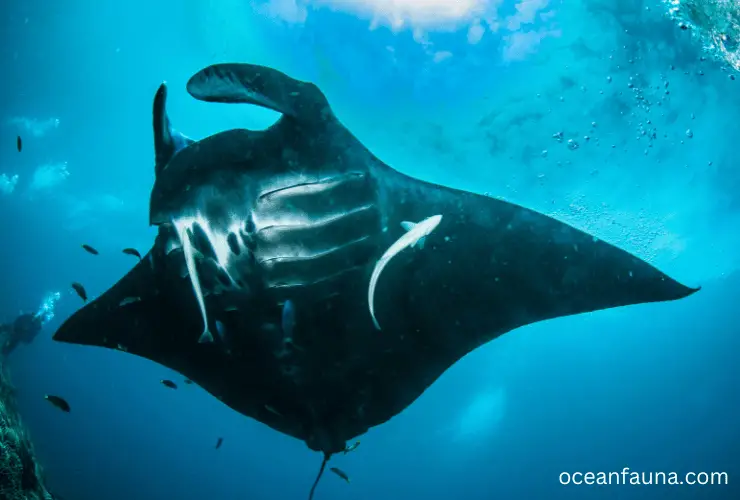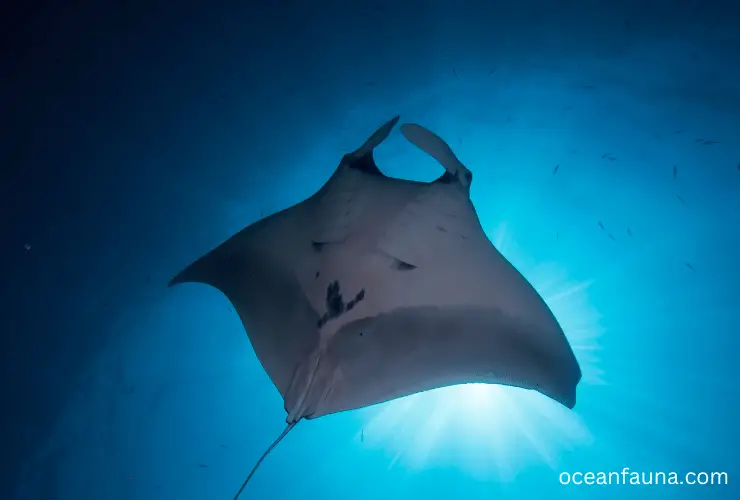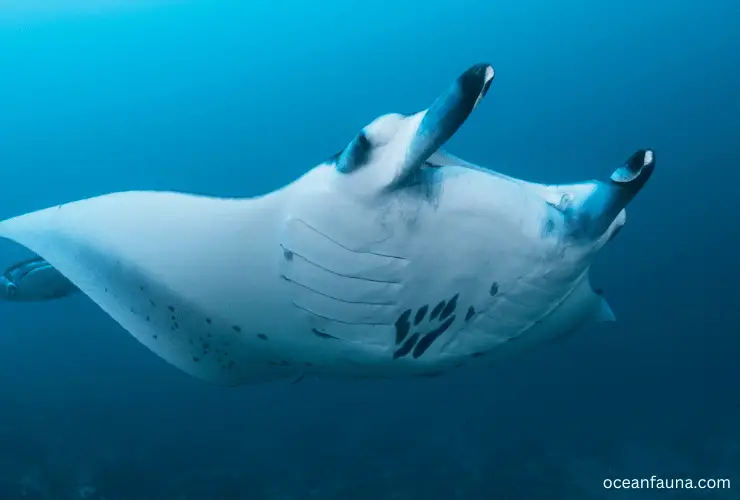No! Manta rays are generally not considered dangerous. They are gentle and non-aggressive animals that are not known to attack or harm people. They are often curious and may approach divers, but they are not known to be aggressive or defensive.
Manta rays are a species of large, flat marine fish in the family Mobulidae. They are found in warm and tropical waters around the world, typically in coastal areas and near coral reefs.
They are known for their large size, distinctive “wings,” and gentle nature. Mantas can reach up to 9 meters in width and can weigh up to 2,000 kg.
Are Manta Rays Dangerous to Humans? Yeah, Or Neah
Manta rays are filter feeders, meaning they feed on plankton and small fish, and have no stingers or venomous spines.
They are not known to be aggressive toward humans, and there are very few reported incidents of manta rays causing harm to people.

However, it’s always important to remember that they are wild animals, and it’s best to maintain a safe distance and avoid disturbing them, especially when they are feeding or mating.
Additionally, Manta rays are vulnerable and endangered species, so it’s important to protect them by following regulations and guidelines when diving or snorkeling with them.
As with any wild animal, there is always a risk of unpredictable behavior. If a manta ray does happen to make contact with a human, it is usually not aggressive and simply trying to defend itself. So, it’s important to understand their behavior and respect their space.
Are Manta Rays Dangerous to Swimmers?
Manta rays are generally not considered dangerous to swimmers. They are also known for their docile and curious nature and tend to avoid contact with humans.
Follow the guidelines set by local authorities when swimming with manta rays or any other wild animals. It’s also important to note that manta rays are vulnerable species, so minimizing human impacts on them and their habitat is crucial.
With all the information about Manta Rays being no threat to swimmers, there are some potential risks to consider when swimming with them:
- Accidents: As manta rays are large and powerful animals, they can hurt people if they feel threatened or disturbed accidentally. It’s important to respect their space and avoid touching or feeding them, and follow the guidelines set by local authorities when swimming with manta rays.
- Disease transmission: Swimming in close proximity to wild animals can increase the risk of disease transmission.
It’s important to be aware of local health guidelines and recommendations and to take appropriate precautions, such as avoiding swimming in areas where water quality is poor or where there are high pollution levels.
- Environmental risks: Swimming with manta rays can also have an impact on the environment. Activities such as feeding, or harassment can disrupt the natural behavior of these animals and can lead to them behaving in unexpected ways.
It’s important to minimize human impacts on manta rays and their habitat.
If you find yourself in a situation where you feel threatened or uncomfortable while swimming with manta rays, it’s best to calmly and slowly back away while keeping an eye on the animal.
If the animal is displaying aggressive behavior, it’s best to quickly leave the area and report the incident to the local authorities.
Are Manta Rays Poisonous?
Manta rays are not poisonous, and they do not have any venomous stingers or toxins. They are generally gentle and passive creatures and do not threaten humans significantly.

While their tails are strong and can deliver a painful sting if they feel threatened, it is unlikely that a manta ray could kill a human.
Is It Okay to Touch A Manta Ray?
Even though Manta Rays are considered to be not a threat to humans, it is not recommended to touch manta rays as they can disrupt their natural behavior and cause stress.
Here are some of the things that can occur to Manta Rays and yourself if you happen to touch a Manta Ray:
- Stress and disruption of natural behavior: Touching a manta ray can cause stress to the animal and disrupt its normal behavior.
- Transfer of oils and bacteria: Human skin may transfer oils and bacteria to the manta ray, potentially harming its health.
- Aggressive behavior: In some cases, manta rays may respond to being touched by becoming more aggressive.
- Sharp fins or teeth: Manta rays have fins and teeth that are not sharp enough to cause any serious harm to any human, but any contact with them could result in injury, so it is best to keep away from them and notice them from a distance.
What To Do If a Manta Ray Approaches You?
If a manta ray approaches you while you are in the water, or if you happen to encounter a Manta Ray when you are swimming, it is best to follow these guidelines:
- Remain calm: Mantas are generally passive creatures and are not likely to attack humans. Avoid splashing or making sudden movements that could startle the manta ray.
- Give it space: Mantas are generally curious animals but require personal space. Keep a respectful distance and avoid touching or harassing the manta ray.
- Do not chase or corner the manta ray: If a manta ray is trying to swim away, do not chase or block its path. This could cause it to feel threatened and result in a defensive response.
- Respect wildlife laws: Check local laws and regulations to determine the appropriate behavior when interacting with manta rays. Some areas may have specific guidelines for swimming and interacting with these animals.
Are There Any Recorded Cases of Manta Ray Attacks on Humans?
There are very few reports of manta rays attacking humans. Manta rays are generally gentle and passive animals and do not pose a significant threat to humans. In most cases, manta rays will swim away from humans if they feel threatened.
However, if a manta ray feels cornered or threatened, it may defend itself by lashing out with its powerful tail, which could result in injury.
Like in this video, it can be seen that Manta Rays have attacked humans just because they might have felt threatened or for any other reason.
Why Do Manta Rays Jump on People?
Manta rays do not typically jump out of the water to land on people. Mantas are curious animals and may approach boats and people to investigate, but they do not typically jump out of the water.
However, there are some reports of manta rays jumping out of the water, but it’s not clear why they do this. Some experts believe that they may attempt to rid themselves of parasites or other organisms attached to the manta’s skin.

Others believe they may be trying to communicate with other manta rays or simply displaying a natural behavior.
It’s also worth noting that some manta rays jumping behavior may be due to human-made activities like feeding or harassment.
These activities can disrupt the natural behavior of these animals and can lead to them behaving in unexpected ways, like jumping. Respecting and not disturbing the wild animals in their natural habitat is important.
FAQs
Do Manta Rays Have Barbs?
No, manta rays do not have barbs. They are a species of ray that belong to the family Mobulidae, and they have smooth, broad bodies without any stinging spines or barbs. They are generally considered to be harmless to humans.
Do Manta Rays Sting?
Manta rays do not have the ability to sting humans. They do not have any stinging cells called nematocysts found in the tentacles of other species of rays and some species of jellyfish. They are generally considered to be harmless to humans and are not known to be aggressive toward humans.
Do Manta Rays Bite?
Manta rays do not have the ability to bite humans. They have a mouth on the underside of their head and a broad, smooth body without any teeth. They feed on small planktonic organisms and do not pose a biting threat to humans.
While diving or snorkeling with manta rays, it is important to maintain a safe distance and respect their space, but there is no need to be concerned about them biting.
Are Manta Rays Mammals?
No, manta rays are not mammals. They are a species of cartilaginous fish, more closely related to sharks and stingrays than to mammals.
How Big Are Manta Rays?
Manta rays are some of the largest species of fish in the ocean, with some individuals reaching sizes of up to 23 feet (7 meters) across from wingtip to wingtip and weight of up to 3,000 pounds (1361 kg).
The larger species, the giant oceanic manta ray (Manta birostris), can have a wingspan of up to 29 feet (9 meters) and a weight of up to 5,300 pounds (2404 kg).
The smaller species, the reef manta ray (Manta alfredi), typically grows up to 18 feet (5.5 meters) across and weighs up to 1,300 pounds (590 kg).
Both species are filter feeders, using their wide cephalic fins to corral plankton and small fish into their wide mouths.
They are also known for their intelligence and complex social behaviors and are often observed interacting with one another and with other marine species.
Fun Facts about Manta Rays
Here are some fun facts about manta rays:
- Manta rays have a unique, complex structure on their heads called “cephalic lobes” that they use to direct water into their mouths while they feed.
- Manta rays are known for their intelligence and complex social behaviors. They are often observed interacting with one another and with other marine species.
- Manta rays have been observed exhibiting behaviors such as somersaults, barrel rolls, and even handstands in the water, which are thought to be displays of playfulness or communication.
- Manta rays have a unique “spotting” pattern on their underbellies, similar to a human fingerprint, and can be used to identify individuals.
- Manta rays are ovoviviparous, which means they give birth to live young.
- Manta rays are considered vulnerable species, and their populations have been greatly reduced due to overfishing and habitat destruction.
- Manta rays have a lifespan of about 20-30 years in the wild.
Conclusion
Hopefully now you understand that although manta rays are not dangerous to humans, they may attack if they feel threatened. So, it is better for both humans and mantas to respect each other’s space.


1 thought on “Are Manta Rays Dangerous? Do They Sting?”